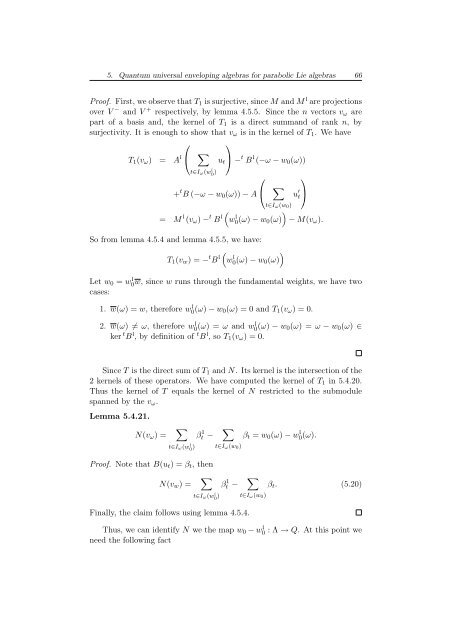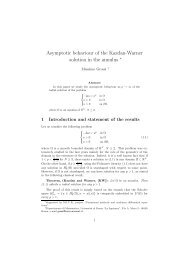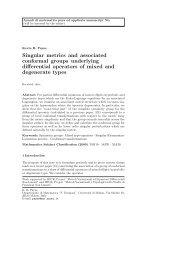Degree of Parabolic Quantum Groups - Dipartimento di Matematica ...
Degree of Parabolic Quantum Groups - Dipartimento di Matematica ...
Degree of Parabolic Quantum Groups - Dipartimento di Matematica ...
Create successful ePaper yourself
Turn your PDF publications into a flip-book with our unique Google optimized e-Paper software.
5. <strong>Quantum</strong> universal enveloping algebras for parabolic Lie algebras 66<br />
Pro<strong>of</strong>. First, we observe that T1 is surjective, since M and Ml are projections<br />
over V − and V + respectively, by lemma 4.5.5. Since the n vectors vω are<br />
part <strong>of</strong> a basis and, the kernel <strong>of</strong> T1 is a <strong>di</strong>rect summand <strong>of</strong> rank n, by<br />
surjectivity. It is enough to show that vω is in the kernel <strong>of</strong> T1. We have<br />
T1(vω) = A l<br />
⎛<br />
⎝ <br />
⎞<br />
⎠ − t B l (−ω − w0(ω))<br />
t∈Iω(w l 0 )<br />
ut<br />
+ t ⎛<br />
B (−ω − w0(ω)) − A ⎝ <br />
t∈Iω(w0)<br />
= M l (vω) − t B l<br />
w l <br />
0(ω) − w0(ω)<br />
So from lemma 4.5.4 and lemma 4.5.5, we have:<br />
T1(vw) = − t B l<br />
w l <br />
0(ω) − w0(ω)<br />
u ′ t<br />
⎞<br />
⎠<br />
− M(vω).<br />
Let w0 = wl 0w, since w runs through the fundamental weights, we have two<br />
cases:<br />
1. w(ω) = w, therefore w l 0 (ω) − w0(ω) = 0 and T1(vω) = 0.<br />
2. w(ω) = ω, therefore w l 0 (ω) = ω and wl 0 (ω) − w0(ω) = ω − w0(ω) ∈<br />
ker t B l , by definition <strong>of</strong> t B l , so T1(vω) = 0.<br />
Since T is the <strong>di</strong>rect sum <strong>of</strong> T1 and N. Its kernel is the intersection <strong>of</strong> the<br />
2 kernels <strong>of</strong> these operators. We have computed the kernel <strong>of</strong> T1 in 5.4.20.<br />
Thus the kernel <strong>of</strong> T equals the kernel <strong>of</strong> N restricted to the submodule<br />
spanned by the vω.<br />
Lemma 5.4.21.<br />
N(vω) = <br />
t∈Iω(w l 0 )<br />
Pro<strong>of</strong>. Note that B(ut) = βt, then<br />
N(vw) = <br />
β 1 t − <br />
t∈Iω(w l 0 )<br />
t∈Iω(w0)<br />
β 1 t − <br />
Finally, the claim follows using lemma 4.5.4.<br />
βt = w0(ω) − w l 0(ω).<br />
t∈Iω(w0)<br />
Thus, we can identify N we the map w0 − w l 0<br />
need the following fact<br />
βt. (5.20)<br />
: Λ → Q. At this point we








